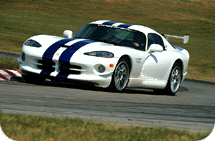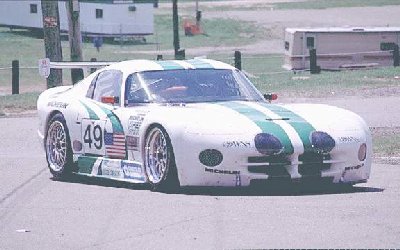Dodge VIPER GTS-R
The latest American
hero
Road & Track's The Best all-around Sports Car
By Matt
DeLorenzo
Photos by Guy Spangenberg
When Chrysler unveiled the
Dodge Viper GTS-R race program during the Pebble Beach Concours d'Elegance
in 1995, the idea of a poduction-based car winning Le Mans seemed
far-fetched. Especially when that car would be pitted against the likes of
the McLaren F1 in GT1 and would compete for the overall win against
open-top WSC prototypes.

Not too surprisingly, the Vipers proved to be no
match for the GT1 cars that by 1996 had begun to morph into new-age Group
C prototypes. Even though the Viper GTS-R finished 10th overall in 1996,
Chrysler subsequently (and realistically) refocused its efforts on the
more production-oriented GT2 category. A good move, as it was rewarded
with a class win at the Sarthe Circuit in June, icing on the cake that was
the overall FIA GT2 championship last year, the first for an American
production car.To commemorate that title, Chrysler has brought its GTS-R
to the street. Originally conceived as a way to provide race cars to
privateers, the Dodge Viper GTS-R program offers turnkey competition cars
with engines tuned to produce anywhere from 525 to 750 bhp depending on
the needs of the customer. Usually those needs are dictated by whatever
class the customer hoped to compete in and the old axiom of "how fast do
you want to go/how much do you want to spend?" In addition to the engine
tweaks, Chrysler also went to the wind tunnel to develop complete
aerodynamic kits for the customer cars.
Chrysler has been cagey on
the price because the cars are essentially custom-built, but it's safe to
say that buying a competition Viper from the factory costs upward of
$200,000.
About 30 or so of these competition cars have been built,
and through the efforts of a decidedly un-American operation, French-run
Team Oreca, Chrysler won both the manufacturer's title and driver's cup
(Justin Bell) last year. Since it's difficult for a corporate entity to
break out the champagne and tie one on, Chrysler has done what it does
best, marking the occasion by coming up with another product to sell, a
limited-production, street-going version of the GTS-R (technically, the
GT2 commemorative edition) priced at $84,500.
Only 100 of these
cars, all 1998 models, are being built and by all accounts, the entire lot
may be spoken for by the time you read this.
Most commemorative
models are just sticker and badge jobs. But the Viper GTS-R offers a bit
more than only graphics. It wears the same kind of aerodynamic pieces as
the original GTS-R. And Project Manager John Fernandez performed a few
hot-rod tricks on the engine's induction system to make the car the most
potent street-going Viper yet.
The package starts with the paint
scheme in the official American racing colors of blue and white. It's no
coincidence that the paint job is reminiscent of the legendary American Le
Mans effort by Briggs Cunningham. After all, his cars were powered by
Chrysler Hemis.
But unlike the Viper that won GT2 at Le Mans this
year, the GTS-R shies away from the competition car's much more aggressive
wings and spoilers. The rear wing is patterned after the one that appeared
on the original GTS-R while the front splitter and winglets are from the
first year's development of the car. But, according to Fernandez, they're
the real thing -- Chrysler even had the parts fabricated by the original
suppliers. The only difference is that the rear wing is set at zero angle
of incidence and can't be adjusted like the ones on the race
cars.
The most ostentatious part of the package is that rear
wing, which is eerily reminiscent of the tall wing on the street versions
of the early Seventies' NASCAR Superbirds. The car, even in white, looks
more menacing than the stock GTS, thanks to the flying airfoil and
aggressive front splitter. The decal commemorating the GT2 manufacturer's
title is classy -- a small American flag with the words "FIA GT2 Champion"
mounted rearward of the driver's-side door glass. There's only one decal;
on the opposite side of the car is the chrome, racing-style filler-cap
cover.
One problem with owning a white Viper is that the heat from
the exhaust pipes, which are still routed through the car's rocker panels
before returning inboard to exit the rear, causes some discoloring on the
exposed part of the doorsill. And even though the open side pipes are long
gone from the Viper, you still have to use extreme caution when exiting
the car, lest you grill a body part on the hot rockers.
The other
functional/appearance upgrades are larger 18-in. web-style alloy wheels
fitted with Michelin Pilot SX P275/35ZR-18 tires on 10-in.-wide front
wheels and P335/30ZR-18s on 13-in.-wide rear wheels. The larger wheels and
tires anticipate a change on all Vipers for the 1999 model year.
Specifically, their 5-spoke alloys will grow from 17 to 18 in. in diameter
and will be fitted with the same tires found on this 1998
GTS-R.
Inside, the interior is trimmed in blue leather and equipped
with 5-point FIA harnesses with the Team Oreca name on them. If getting in
and out of a 5-point harness isn't part of your daily regimen, you can
push the webbing out of the way and use the standard 3-point belt with its
outboard buckle. To finish things off, there's a silver commemorative
plaque on the console to distinguish this collector Viper from the
standard GTS coupe.
Beneath the hood, the inner workings of the
aluminum V-10 remain the same, but Fernandez says some power was gained by
helping the engine breathe easier. Specifically, the intake tubes were
straightened, the airbox revised, and low-restriction K&N filters
replace the stock units. These changes bump the horsepower by 10 to 460
bhp delivered at 5200 rpm. Better still, torque is now 500 lb.-ft. (up 10)
and peaks 100 revs sooner at 3600 rpm.
The extra muscle showed at
the drag strip where the GTS-R blistered its way to 60 mph in 4.2 seconds,
a tenth quicker than our previous best with a standard GTS coupe. The car
also showed improvement in the quarter-mile, recording a time of 12.5
sec., same as the GTS coupe, but with a higher trap speed of 118.5 mph.
The larger wheels and more aggressive tires also provided more grip,
allowing us to edge up our slalom speed from 63.6 to 65.3 mph as well as
take several feet off the Viper's (still non-ABS) stopping distances (60-0
improved from 155 to 147 ft., 80-0 dropped from 278 to 253
ft.).
The GTS-R further enhances the Viper's reputation as our
hemisphere's king of performance numbers-it remains the quickest,
best-handling sports car available from an American manufacturer. And true
to its race-bred heritage, the GTS-R, like all GTS coupes, drives like a
race car. In other words, what it provides in raw acceleration, grip,
visual and visceral excitement, it lacks in the basic refinements that
we've come to expect in sports cars that you can use every day.
The
seating position is a bit awkward, your legs crab left slightly, and while
the adjustable pedals help in maintaining a good relationship to the
controls, there's no dead pedal for your left foot. During spirited
driving, the pedals themselves felt loose on their pivots, as if they were
going to get caught up in my right foot as it danced from accelerator to
brake and back. Also, the gearshift lacks some precision on the 2-3 and
4-5 upshifts. When hurrying shifts you can find yourself inadvertently
catching 1st instead of 3rd, 3rd instead of 5th.
The steering,
though a bit vague on-center, is wonderfully quick and responsive when
correcting for power-induced oversteer. The GTS-R is a light-'em-up,
bucking bronco of a car that begs to be driven and steered with the
throttle. There's no traction control to deactivate, no pulsing ABS on the
huge 13-in. discs to warn you of wheel lockup. The GTS-R responds
delicately to light trail-braking going into corners and then savagely to
a heavy foot from apex to exit. It's a thrill ride few street cars can
offer-and none at the Viper's price.
The Viper GTS-R is loud and
exuberant, serving up bags of torque from its nearly 8 liters of
old-fashioned pushrod engine. It is big FUN written in all caps. In a way,
it embodies the sort of virtues -- bigness, optimism and the promise of
mammoth power -- that Europeans have come to expect from
Americans.
Now that the Viper GTS-R has conquered the FIA GT2 class
and Le Mans, it has shown the world it's America's Sports Car. Which
places the ball in Chevy's court --Viper vs. Corvette at Le Mans? How
about it?
|
